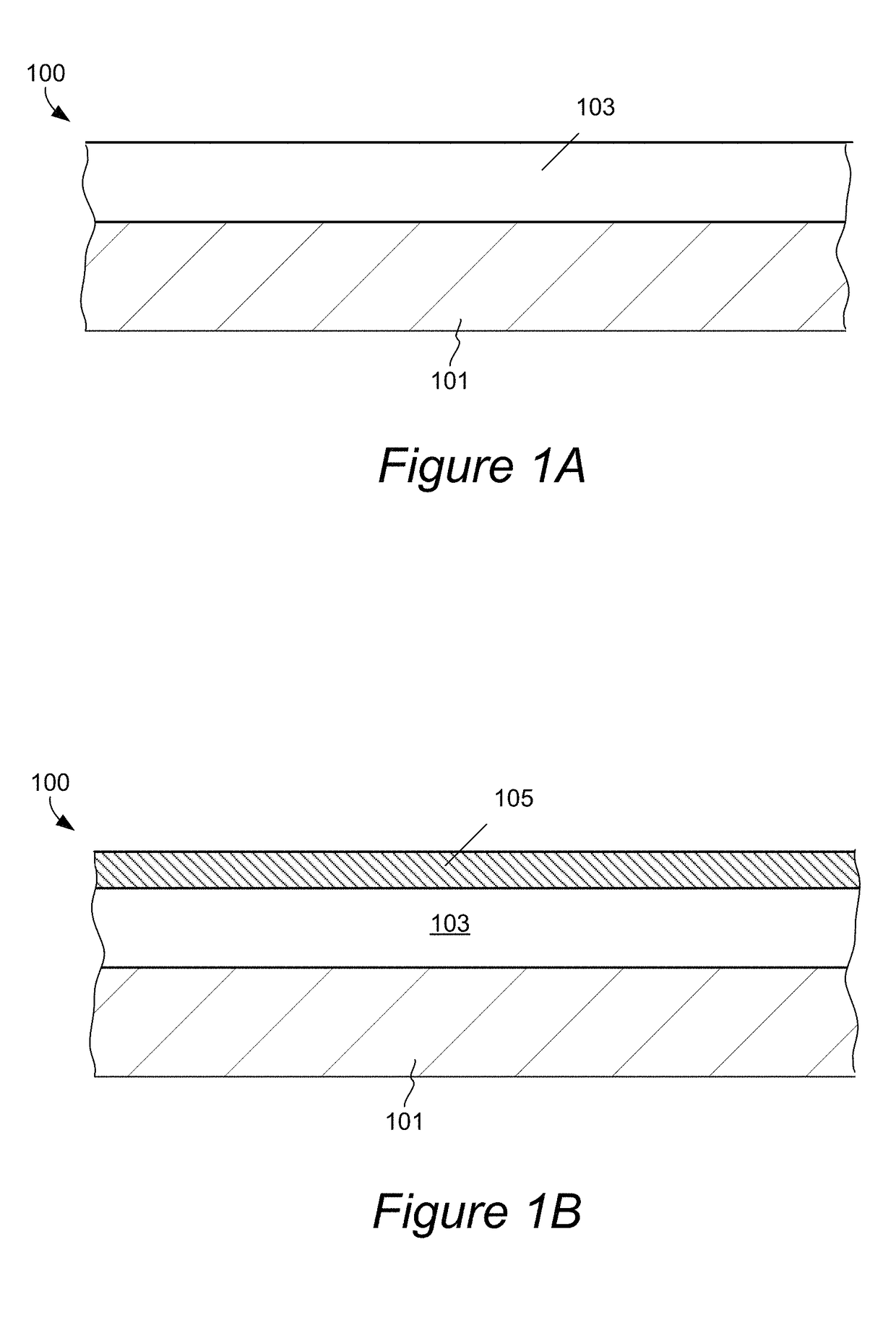Low temperature formation of high quality silicon oxide films in semiconductor device manufacturing
a technology of silicon oxide film and low temperature, applied in the direction of coating, chemical vapor deposition coating, metallic material coating process, etc., can solve the problems of unacceptably high stress value of conventional low temperature pecvd and less attractive for use as hardmasks, and achieve the effect of reducing the stress of the deposited layer
- Summary
- Abstract
- Description
- Claims
- Application Information
AI Technical Summary
Benefits of technology
Problems solved by technology
Method used
Image
Examples
experimental examples
Example 1. Formation of Silicon Oxide Films Having Low Stress and High Density
[0081]A number of silicon oxide films were deposited by PECVD in a Vector PECVD reactor available from Lam Research Corporation, Fremont Calif., on planar 300 mm wafers at a temperature of 180° C., and pressures of 2.5 Torr-3.5 Torr. The process gas used during deposition consisted of SiH4 (provided at 30 sccm), CO2 (provided at 4200 sccm) and He. Plasma was generated in the process gas using HF RF generation at 13.56 MHz at a power level of 100-400 W. The deposition was conducted for 5 seconds; then the flows of SiH4 and CO2 into the process chamber were stopped, while the plasma and helium flow remained on for 5 seconds to purge the SiH4 and CO2 out of the process chamber. Next, plasma power was increased to 500-1000 W and helium flow was increased to 1000-4000 sccm and the deposited silicon oxide films were plasma treated under these conditions for 6-20 seconds. Temperature and pressure remained constan...
example 2
of Formed Low-Stress Films
[0082]An FT IR spectrum of a low-stress silicon oxide material was obtained. The film was formed as described in Example 1, using the following process parameters: temperature of 180° C., pressure of 3.5 Torr, plasma power of 100 W (generated at 13.56 Mhz), SiH4 flow rate of 30 sccm, CO2 flow rate of 4200 sccm and He flow rate of 1250 sccm. The formed film had a stress of less than −40 MPa. It can be seen that the FT IR spectrum does not have a Si—H peak at about 2250 cm−1, which is typically present in silicon oxide films deposited by low temperature PECVD without plasma post-treatment. This indicates that plasma post-treatment reduces the concentration of hydrogen in the formed films.
example 3
nt of Stress, Density, and RI by Plasma Post-Treatment
[0083]A comparative silicon oxide film was deposited by low temperature PECVD to a thickness of 411 Å, and its stress, density and RI were measured. The deposition was conducted at a temperature of 180° C., and pressure of 3.5 Torr, using plasma power of 100 W (13.56 Mhz), SiH4 flow rate of 30 sccm, CO2 flow rate of 4200 sccm and He flow rate of 1250 sccm.
[0084]Another silicon oxide film was deposited by low temperature PECVD using the same process conditions as those used in the deposition of the comparative film above, and was then plasma treated at a temperature of 180° C., pressure of 3.5 Torr, using plasma power of 500 W (13.56 Mhz), and He flow rate of 1000 sccm. Stress, density, and RI of the treated film were measured.
[0085]Parameters for the comparative film and for the treated film are provided in Table 4.
[0086]
TABLE 4Improvement of stress, density, and RI upon plasma treatment.ParameterComparative FilmTreated FilmStres...
PUM
| Property | Measurement | Unit |
|---|---|---|
| Temperature | aaaaa | aaaaa |
| Temperature | aaaaa | aaaaa |
| Temperature | aaaaa | aaaaa |
Abstract
Description
Claims
Application Information
 Login to View More
Login to View More - R&D
- Intellectual Property
- Life Sciences
- Materials
- Tech Scout
- Unparalleled Data Quality
- Higher Quality Content
- 60% Fewer Hallucinations
Browse by: Latest US Patents, China's latest patents, Technical Efficacy Thesaurus, Application Domain, Technology Topic, Popular Technical Reports.
© 2025 PatSnap. All rights reserved.Legal|Privacy policy|Modern Slavery Act Transparency Statement|Sitemap|About US| Contact US: help@patsnap.com



